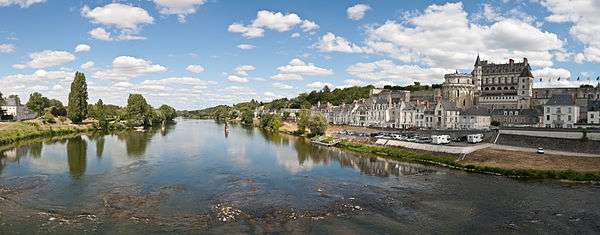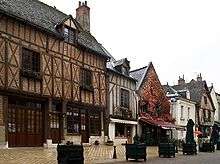Amboise
| Amboise | ||
|---|---|---|
|
Amboise, street near the castle | ||
| ||
 Amboise | ||
|
Location within Centre-Val de Loire region  Amboise | ||
| Coordinates: 47°24′15″N 0°58′48″E / 47.4042°N 00.98°ECoordinates: 47°24′15″N 0°58′48″E / 47.4042°N 00.98°E | ||
| Country | France | |
| Region | Centre-Val de Loire | |
| Department | Indre-et-Loire | |
| Arrondissement | Tours | |
| Canton | Amboise | |
| Government | ||
| • Mayor (2008–2014) | Christian Guyon | |
| Area1 | 40.65 km2 (15.70 sq mi) | |
| Population (2009)2 | 12,505 | |
| • Density | 310/km2 (800/sq mi) | |
| Time zone | CET (UTC+1) | |
| • Summer (DST) | CEST (UTC+2) | |
| INSEE/Postal code | 37003 / 37400 | |
| Elevation |
52–127 m (171–417 ft) (avg. 58 m or 190 ft) | |
|
1 French Land Register data, which excludes lakes, ponds, glaciers > 1 km² (0.386 sq mi or 247 acres) and river estuaries. 2 Population without double counting: residents of multiple communes (e.g., students and military personnel) only counted once. | ||
Amboise (pronounced: [ɑ̃bwaːz]) is a commune in the Indre-et-Loire department in central France. It lies on the banks of the Loire River, 27 kilometres (17 mi) east of Tours. Today a small market town, it was once home of the French royal court. The town of Amboise is also only about 18 kilometres (11 mi) away from the historic Château de Chenonceau, situated on the Cher River near the small village of Chenonceaux. Its former name was Ambacia, from the old name of the river and marsh Amasse.
Population
| Historical population | ||
|---|---|---|
| Year | Pop. | ±% |
| 1793 | 5,659 | — |
| 1800 | 5,113 | −9.6% |
| 1806 | 5,097 | −0.3% |
| 1821 | 5,276 | +3.5% |
| 1831 | 4,613 | −12.6% |
| 1836 | 4,695 | +1.8% |
| 1841 | 4,715 | +0.4% |
| 1846 | 4,956 | +5.1% |
| 1851 | 4,762 | −3.9% |
| 1856 | 4,433 | −6.9% |
| 1861 | 4,570 | +3.1% |
| 1866 | 4,188 | −8.4% |
| 1872 | 4,216 | +0.7% |
| 1876 | 4,475 | +6.1% |
| 1881 | 4,167 | −6.9% |
| 1886 | 4,592 | +10.2% |
| 1891 | 4,480 | −2.4% |
| 1896 | 4,463 | −0.4% |
| 1901 | 4,538 | +1.7% |
| 1906 | 4,731 | +4.3% |
| 1911 | 4,660 | −1.5% |
| 1921 | 4,625 | −0.8% |
| 1926 | 4,483 | −3.1% |
| 1931 | 4,129 | −7.9% |
| 1936 | 4,236 | +2.6% |
| 1946 | 4,443 | +4.9% |
| 1954 | 6,736 | +51.6% |
| 1962 | 7,953 | +18.1% |
| 1968 | 8,625 | +8.4% |
| 1975 | 10,680 | +23.8% |
| 1982 | 10,857 | +1.7% |
| 1990 | 10,982 | +1.2% |
| 1999 | 11,461 | +4.4% |
| 2006 | 12,691 | +10.7% |
| 2009 | 12,505 | −1.5% |
Sights
The city is famous for the Clos Lucé manor house where Leonardo da Vinci lived (and ultimately died) at the invitation of King Francis I of France, whose Château d'Amboise, which dominates the town, is located just 500 m (1,640 feet) away. The narrow streets contain some good examples of timbered housing.
Just outside the city is the Pagode de Chanteloup, a 44 m (144.4 feet) tall Chinese Pagoda built in 1775 by the Duke of Choiseul. The Pagoda is seven levels high, with each level slightly smaller than the last one. An interior staircase to reach all levels is open to the public.
The Musée de la Poste (in the Hôtel Joyeuse) is a museum tracing the history of the postal delivery service.
A 19th-century fountain by John Oswald of a turtle topped by a teddy bear figure stands in front of the spot where the markets are held.
-

Amboise viewed from the Château d'Amboise
-

'Tour de l'Horloge' (the Clock Tower).
-

Exterior shot of the Clos Lucé Mansion
-
Château d'Amboise over Loire
-
Amboise (cityview from the castle)

History

Clovis I (c. 466–511) and the Visigoths signed a peace treaty of alliance with the Arvernians in 503, which assisted him in his defeat of the Visigothic kingdom in the Battle of Vouillé in 507.
Joan of Arc passed through in 1429 on her way to Orleans to the Battle of Patay.
The Amboise conspiracy was the conspiracy of Condé and the Huguenots in 1560 against Francis II, Catherine de' Medici, and the Guises.
The Edict of Amboise (1563) conceded the free exercise of worship to the Protestants.
The Château at Amboise was home to Mary Stewart, Queen of Scots, for much of her early life, being raised there at the French court of Henry II. She arrived in France from Scotland in 1548, aged six, via the French king's favourite palace at Saint Germain en Laye near Paris, and remained in France until 1561, when she returned to her homeland - sailing up the Firth of Forth to Edinburgh on 15 August that year.
Leonardo da Vinci spent the last years of his life in Amboise. Some of his inventions are still there and have not been removed. Leonardo died in the arms of King Francis I,[1] and he was buried in a crypt near the Chateau d'Amboise.

The house has lost some of its original parts, but it still stands today and has a beautiful overlook of the Loire River.
Here was born in 1743 – Louis Claude de Saint-Martin French philosopher, known as Le Philosophe Inconnu. (d. 1803).
Abd el Kader Ibn Mouhi Ad-Din (c. 1807–83) was imprisoned at the Château d'Amboise.
International relations
Twin towns – Sister cities
Amboise is twinned with:
-
 Boppard, Germany
Boppard, Germany -
 Fana, Mali
Fana, Mali -
 Suwa (province of Nagano), Japan
Suwa (province of Nagano), Japan -
 Vinci, Italy
Vinci, Italy -
 Baleni (province of Galati), Romania
Baleni (province of Galati), Romania
See also
References
External links
| Wikivoyage has a travel guide for Amboise. |
| Wikimedia Commons has media related to Amboise. |
- Architecture of Amboise
- Monument Historique de la Loire : La Pagode Chanteloup
- Château Gaillard, Amboise
.svg.png)
